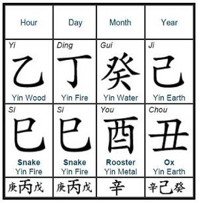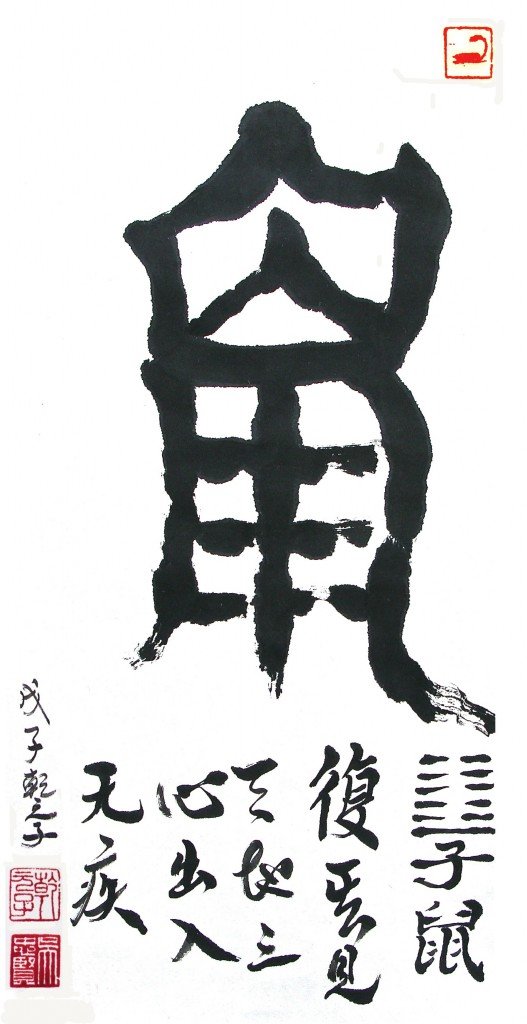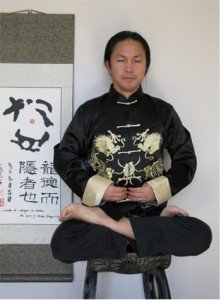Chinese Astrology and Inner Cultivation
By Master ZhongxianWu
After my book The 12 Chinese Animals — Create Harmony in Your Daily Life through Ancient Chinese Wisdom was published, some friends often ask me, “Why should I learn about the Chinese animal symbols? Are the animal signs related to my Qigong practice or spiritual cultivation? How important is it to know about this knowledge?” To answer these questions, I would like to start with a little background on my studies of Chinese astrology:
I grew up in a traditional fishing village in southeast China, and for my entire upbringing, I saw that people commonly used astrology to help make decisions about important events (finding a spouse, setting a wedding date, building a house, opening a business, health issues, etc). Because our village had no electricity, pipe water, or roads larger than a footpath, we all lived very closely with the rhythms of nature. Chinese astrology is the art of living in harmony with the hourly, daily, monthly, and yearly cycles of life.
As long as I can remember, my mother has always consulted the local Yijing or astrology experts when she needs help or advice. As a child, I was fascinated by the accuracy of their advice and their ability to predict outcomes. I became interested in learning more about astrology and its connection to Chinese medicine and the Yijing prediction system. I began to study this art with the intent of being able to help others. Now, my main focus is teaching Qigong, Taiji and the Yijing to help people create harmony in their life. Through my experience of over 20 years of teaching these ancient Chinese wisdom practices, I have seen that Chinese astrology is a great tool to help guide people through their life and their inner cultivation.
2. The Complexity of Chinese Astrology 
In the West, most people think that Chinese astrology is only about their yearly animal sign. I think the misconception in the West is mostly for convenience sake, to offer a view of Chinese astrology that is over simplified and therefore more available for the general public and more for entertainment value.
In China, we call astrology BaZi 八字 (8 characters) or MingLi 命理 (principle of your destiny or karma), but only a small amount of people actually understand how to put together and interpret a chart. Most Chinese have to find an expert to help them, and finding someone really qualified and skillful can be challenging. Of course, you may easily find a fortuneteller on the street, but they are usually not very accurate. The Chinese astrology system is extremely complicated, and the deep intricacies of the system is difficult for most people to understand.
The yearly animal sign is a small percentage of what influences your entire chart. In my book, The 12 Chinese Animals, I also discuss the monthly and daily animal sign, which will help people develop a fuller understanding of their chart. Most people do not realize that the 12 animals also relate to the 12 tidal hexagrams of the Yijing. The Yijing, of course, is a method of understanding the rhythms of nature and of life. When I wrote this book, I wanted people to get a little taste for the complexity behind the Chinese astrological system. It is important to realize that the 12 animals is just one aspect of Chinese astrology — creating and understanding a whole chart for the sake of prediction is a much more complicated process.
3. Make Better Choices
The use of Chinese animal symbols is a key to understanding the principles of your life and of your karma. They can help you understand your strengths and your weaknesses. Becoming conscious of your own patterns will give you information about how to cultivate your gifts and refine your challenges, which will help make your life flow more easily, with fewer struggles, and bring you success in your pursuits.
I use the practices to guide my inner cultivation in order to balance and strengthen my astrological chart (which varies depending on the hour, day, month, season, year, or external life event), so that I feel more harmonious with my self, my family, and with nature. For example, I will check the Chinese calendar to pick out dates for travel, signing a contract, or teaching. Based on the animal symbols, I also chose special colors for our home and office in order to create the right Fengshui for those environments. My wife and I set our daily routine (sleeping, cultivation practices, menu planning and food preparation, etc) according the principles of the Chinese animal clock in order to create a healthy daily rhythm for our family.
4. Shape Your Destiny
If you want to change your karma, you have to know what your karma is. A good understanding of Chinese astrology does more than just help you understand your karma and make predictions for the future. The real purpose of the reading is to guide you to make changes in your life, from daily lifestyle habits to larger life decisions. Knowing your chart will direct you when you are seeking healing and balance in yourself and in your relationships. Understanding the interplay of the Universal energies present in your life will help you guide your Qigong practice and spiritual cultivation to change your karma, remain centered when something unexpected happens, steer clear of trauma, and put you on the path of health, prosperity, and longevity.
For thousands of years, the essence of Chinese philosophy holds that life is not merely controlled by fate or karma — wo ming zai wo bu zai tian 我命在我不在天 — “My life is in my hands, and is not controlled by fate.” Through mindfulness and effort, we all have the ability to change our karma and achieve true autonomy. By understanding the Chinese 12 animal symbols and 12 tidal hexagrams from Yijing wisdom, you will be able to learn a way to find your inner peace and live in harmony with your family, your community and with nature. The winter season is the best time for your to looking within and it is time for you to recreate your new karma, especially in the winter solstice time period. I would like to share some information here about the energetic pattern of winter solstice and inner cultivation from my new book The 12 Chinese Animals — Create Harmony in Your Daily Life through Ancient Chinese Wisdom.
5. Hexagram Fu (Rebirth)
Fu is the tidal hexagram that represents the energetic pattern of the Rat animal symbol. The Chinese character Fu means return, repeat, recover, and rebirth. The symbol of the hexagram made with one Yang line at bottom and 5 Yin lines on top, which represents Yang Qi, or new life energy, returning back in a natural cycle. It is the symbol for rebirth and rejuvenation.
In an annual cycle, Fu represents Zi – the month in which winter solstice occurs. Zi month lasts from approximately December 7th to January 5th in solar calendar. Winter solstice is the shortest day and longest night of the year, which in the Chinese tradition, means Yang Qi has dropped to its nadir and Yin Qi has climbed to its zenith. Literally, winter solstice landmarks the point at which we begin to experience the gradual reversal of lengthening nights and shortening days. The winter solstice is the turning point of Yang energy. Depending on the sun’s changing position, the winter solstice occurs some time between December 21 and December 22 each year (in the northern hemisphere).
In old Chinese tradition, we have a big winter solstice celebration. It was one of my favorite childhood Chinese festivals. In my memory, families gathered in the kitchen to prepare the sacrificial food on the winter solstice eve. My grandmother made many kinds of animal dolls from rice flour. My brother and I would help make the TangYuan (small rice balls). In the early morning of the next day, the first thing my family did was bring out TangYuan, rice animal dolls, and other sacrificial foods to offer to Nature. Although most modern city people in China do not make this kind of offering, most northern Chinese families will still eat JiaoZi (dumplings) and most southern Chinese families will still eat TangYuan at the winter solstice.
Both JiaoZi and TangYuan are symbols representing Yang Qi. Eating JiaoZi or Tangyuan during the winter solstice is a way to remind us to hold Yang energy within and keep warm during the cold winter. In Chinese wisdom traditions, it is one of the best times of the year to do your inner cultivation because the universal Yin energy will reach the peak level and the Yang energy will be re-born. We need spend more time doing Qigong and meditation to support the rebirth of our inner Yang energy on the winter solstice day.
In the daily cycle, Fu stands for Zi time which is 23:00 – 00:59. Like winter solstice, midnight is the time when Yang Qi returns in your body and begins to increase. Zi is the great time for you to do inner cultivation. Or, if you are not practicing any inner cultivation, it would be a good habit to go to bad before 23:00.
Let us uncover more information about Fu from Yijing wisdom. Like all hexagrams, hexagram Fu is made up of two trigrams. In this hexagram, the top trigram is Kun (Earth) and the bottom trigram is Zhen (Thunder). It is an image of Thunder within the Earth. Thunder is the symbol for shaking off old patterns of stagnation and creating new life energy or power. Earth is the symbol for holding yourself stable or centering your mind. Hence, hexagram Fu is an image of inner cultivation. Just like your meditation, when you steady your body, mind, and breath, you will be able to feel your Yang Qi generating automatically within your body. If you can center yourself from deep within, you may feel Qi shaking in your body just like thunder and lightening.
When I do not feel well or when I am beginning to feel sick, first thing I do is to practice some Qigong or meditation to help me find my life energy back and recover by the inner cultivation. Many my students have recovered from sickness through their Qigong or Taiji practice. When I have a challenge in my life, first thing I do is to take a deep breath to my Dantian and bring my mind back to my body. And this always helps me shift the challenge quickly and makes my life easy and peaceful. This is what I have learned from the hexagram Fu, Rebirth. I hope you can try some inner cultivation with me at Fu time, the time that will give you feeling of rebirth everyday. I would be happy if you learned more about the hexagram Fu from your inner cultivation practice.
6. Inner Cultivation Fu ceremony:
At 11pm every night, light a candle in front of you and start the meditation with your hands in Fu mudra. (figure) Fu mudra is made by touching each thumb to the base of the ring fingers. The palmer crease of the ring finger is associated with hexagram Fu. (figures-mudra and palm with fu hexgram) Make sure to keep your fingers together and relaxed. Then, place your mudra with palms on your belly and middle fingers touching the navel. First open your eyes and look directly at the candlelight. Then, close your eyes and imagine the candlelight in your Dantian (lower belly). Adjust your breathing to be slow, smooth, deep and even. Feel how each breath makes the light brighter and brighter in your Dantian. Meditate as long as you can. Before ending, please say a little prayer –
“May the Spiritual Lights shine within my heart and body,
May the Spiritual Lights shine within my family and friends,
May the Spiritual Lights shine within all beings,
May the Spiritual Lights always shine with peace and harmony for the World!”
[Master Zhongxian Wu is the recognized master of multiple lineages of classical Qigong, Taiji and martial arts. He synthesizes wisdom and experience for beginning and advanced practitioners, as well as patients seeking healing, in his unique and professionally designed courses and workshops. He is the author of Seeking the Spirit o f The Book of Change, The Vital Breath of the Dao, and The 12 Chinese Animals — Create Harmony in Your Daily Life through Ancient Chinese Wisdom. Please visit www.masterwu.net for further details about his teachings.]
(Acknowledgements: Karin Elizabeth Taylor Wu provided editorial assistance for this article.)




One Response to From the Master